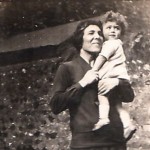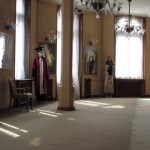Chapter 2: Bucharest
Beyond Dreams of Aberystwyth | The Book
Bucharest is much as the guide books will tell you – a hotch-botch mix of beautiful old villas covered in vines and surrounded by citrus fruit trees and wide historic boulevards – cheek-by-jowl with concrete monstrosities put up in communist times, the latter sometimes completely surrounding the former, or even leaning up against them, no town planning, some strategically done to blot out the past.
There is a stray dog situation which is a bit upsetting. It was sad to see them wandering around homeless, curled up on the street for a bed. Some Romanians clearly love their dogs but these lost ones seemed to be just part of the background. There is dog shit everywhere and they have a big barking session at night. Can you blame them?
One of the things that occurred to me while walking around is why any Jews would want to stay – in Romania or anywhere in Europe – after the Holocaust? I mean enough’s enough isn’t it? Most Jews who survived in Romania emigrated afterwards.
- Jewish population pre WW2: 800,000
- After: 400,000
- Number who emigrated after: 300,000
I wonder if this has been felt as a loss by non-Jewish people? Anti-semitism has had such a strong presence in Europe for so long, I can only think there must be a section of society even now that thinks ‘Oh well, that’s a relief, that was a problem solved! Everything is so much better now…’ Is it? I know it’s a long time ago, but when I walked down the streets of Bucharest I was somehow looking for something in the faces of the people, the legacy of this past in subsequent generations. I imagined I saw a sadness or an emptiness that comes from not knowing where your sadness comes from. But I could have been imagining.
The first place I was looking for was the Choral Synagogue – which I found, covered in scaffolding and being restored –closed, bah. No one spoke English, but I managed to communicate to one man that my grandmother was Jewish and born in Romania. ‘Ahh!’ He took my hand, a huge open smile, like I’m a long lost daughter! He happily took me round the corner and pointed me in the direction of the Jewish Museum – and left me at the corner with a French-type-cheeks-kiss.
The Jewish Museum in another former synagogue, the Tailors Synagogue. A lovely older woman called Helga talked to me and again lit up the most beautiful smile when I told her about my grandmother. I got out my huge notebook with my meagre genealogical facts – she said many Jewish people come to Romania from all over the world looking for their roots – but I had more information to start with than most (well I am a Capricorn). She also said the Centre for Research into Jewish History of Romania was upstairs! Hurray!
Before I went up I had a look around the Museum first. And rather than turn this (anymore than it already is) into an obscure history lesson, I’ll tell you what I got from it – what I saw in the history and culture shown there that I find in myself, never mind the uncertain specifics of births, places and dates of long dead family.
Romanian Jews have been:
- Writers
- Radicals
- Historians
- Poets
- Actors and theatre makers
- Producers of culture and music
- Tailors (I like sewing)
- Possess a satirical sense of humour
After that I went to the Research Centre and gave them as much information as I could about my family history, but it was difficult to explain it all with the limited language exchange. I am beginning to understand why people employ people to do all this, if only I had the backing of the BBC, or a team of translators and researchers behind me! I started to let go a little of finding out much about my particular family, much as I’d like to. But this has always been a more spiritual quest, to see the places my ancestors lived, to try to capture an essence of them, their lives, the transition they made leaving.
Then I went to the Holocaust Museum, also in a synagogue, the Great Synagogue. This is a working synagogue. All around the walls are the panels of the Holocaust exhibition, which I thought must be rather hard for the Jewish people worshipping there. But maybe this grim story is so much a part of Jewish consciousness in Europe, having it baldly shown on the walls is not so hard, more a reflection of what is? I didn’t ask.
A very old man, extremely graceful and dignified welcomed me. He put on a capul and took me around the synagogue and museum, explaining everything in a very precise, slow and practised English, what was clearly a well-worn script, but with total courtesy and genuineness. The exhibition was awful to see of course. Even though Romania only came late into the war, and only deported Jewish people to the Nazi death camps from northern Romania later, they practised their own regime of pogroms and deportations to their own camps – in Transinistra, now part of Ukraine – where Jewish people had no food or shelter and simply died of starvation and disease, or as the man said ‘of misery.’ At the end of the exhibition there was a photograph of a row of children dated 1944: ‘Orphans who have been re-patriated from Transinistra to Romania.’ And I thought of my Dad (born 1928, a little older then that the children shown) and of his mother Polly, and how glad – and how randomly lucky – she and so many like her must have felt to have got out of there when they did – to escape all that – and see their children safe.
The Holocaust is beyond disturbing.
The reality of it began to unfold for me again when I look at one of the first photos in the exhibition. At first, despite the context of where I am, I am puzzled by it. Someone (gender not clear) is lying on the snow, the lower half of their body naked. In the foreground someone else is lying completely naked face down on the snow. There are a few figures in dark coats on the edges of this and some trees, it looks like a park. My first almost naïve thought, is what is going on here? There is something really odd, no, really disturbing going on here… Those people must be… dead? Why else would anyone be lying naked in the snow and people standing around looking?
I can almost understand how a one-off murder could occur, or even an isolated hate crime, someone at the end of their rope with wrong ideas in their psyche. That’s crossing a line, not only to the person hurt, but for the perpetrator – you’ve crossed a line within your own soul to do that to someone. But for so many to be involved, to cross those lines repeatedly, against all human dignity, and for so many horrors to be committed in such an organised fashion on so many… Well, that is a Holocaust.
That photo was the beginning of how started in Romania – a photo of when 120 Jewish men were taken from Bucharest to a park and shot. I wasn’t sure how I was going to cope with Auschwitz after this but I still wanted to go.
After that I was glad to make my way to the Jewish State Theatre, which was totally fab! My Dad was an actor, he trained at RADA – the Royal Academy for Dramatic Arts – and his spirit really came back to me and touched me in this place, as well as my own (often suppressed) love for the theatre. They are such exciting places to be! My Dad was never very at home in places like synagogues, but put him in the theatre..! I thought if my father had been raised here, maybe he would have played on this stage. There were many Jewish theatres in Romania once, and this is the last remaining one. During the war, as Jewish actors were excluded more and more from the right to work, they moved towards this theatre, and after the war it was made Romania’s Jewish State Theatre. Now there’s a thing in itself – the theatre and its company of 83 (actors and production team) are fully funded full time by City Hall. How amazing is that? The posters outside the Jewish State Theatre were none of that post-modern high design concepts for you – simply colour, drama and people acting – I loved them.
I got a tour from the production manager Marcel Draghici, a non-Jewish Romanian who reminded me of my partner in his inexplicable draw to Jewish culture. “I feel close to these people.” The theatre tries to put on most of its plays in Yiddish, but of the 83 working there, only 10 are Jewish. They try to do plays on Jewish themes or playwrights, but have to think about the inevitable ‘bums on seats’ pressures too, and the funding of City Hall. I asked if they get Jewish audiences and Marcel said sadly “Not too much.” The reason being Jewish people are quite poor and can’t afford the tickets, and many are old and can’t make it up the stairs! But despite the mixed sense of how Jewish it was, there seemed a genuine commitment to honour and celebrate Jewish culture. I loved the faded grandeur of the place, and the memories you could feel walking the corridors. I hope they don’t do it up. There was a photo of their production of ‘Fiddler on the Roof’ (of course) up there too! Marcel told me that Jewish people come from all over the world. It felt inspiring to meet a non-Jewish Romanian too, so connected and committed to Jewish people, people working together, and intelligent and interested in the whole world. “I think you people are amazing. You carry on.” True enough.
Back to Chapter 1
Forward to Chapter 3
Full Table of Contents
If you have enjoyed this and would like to see ‘Beyond Dreams of Aberystwyth’ go further please click on this link to see what you can do to help make that happen! You can also submit comments below. Thanks for reading.










